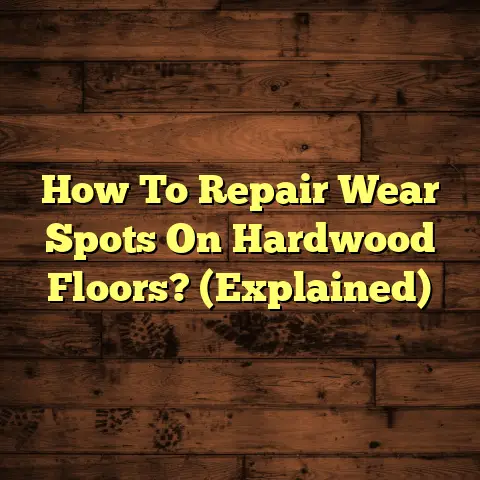Is Wide Plank Better? (7 Things To Know!)
Flooring. It’s more than just something you walk on.
It’s the foundation of your home’s style, the silent storyteller of your daily life, and a major player in boosting your property’s overall value.
Think about it: have you ever walked into a house and immediately been struck by the flooring?
I know I have. That’s the power of a well- chosen floor. And lately, the spotlight has been shining brightly on one particular trend: wide plank flooring.
It’s everywhere – in magazines, on home improvement shows, and increasingly, in the homes of my clients.
But is it really better? That’s the million- dollar question.
As a flooring contractor with years of experience under my belt, I’ve seen firsthand the impact flooring choices can have.
It’s not just about looks; it’s about durability, cost, maintenance, and even how it sounds when you walk across it.
Choosing between wide plank and traditional flooring isn’t just a matter of aesthetics; it’s a decision that can significantly affect your home’s value and your enjoyment of it for years to come.
So, let’s dive in, shall we? Over the next few minutes, I’m going to walk you through seven key things you need to know about wide plank flooring.
We’ll explore everything from its stunning visual appeal to the nitty-gritty details of installation, durability, cost, acoustics, environmental impact, and ultimately, how it can affect your home’s resale value.
By the end of this article, you’ll have a clear understanding of whether wide plank flooring is the right choice for you and your home.
Ready? Let’s get started!
Section 1: Aesthetic Appeal
Okay, let’s be honest. The first thing that draws most people to wide plank flooring is its sheer visual impact.
It’s just… striking.
Think about it: instead of a series of narrow strips, you have these expansive, beautiful boards stretching across your floor.
The effect is immediately more seamless and spacious. It creates a sense of openness that narrower planks simply can’t match.
I often tell my clients that wide planks can make a room feel bigger, even if the square footage is exactly the same.
It’s an optical illusion, sure, but it’s a powerful one.
But it’s not just about creating space. Wide planks also add a touch of elegance and sophistication.
They showcase the natural grain and character of the wood in a way that narrower planks often obscure.
You get to see more of the wood’s unique personality – the knots, the swirls, the subtle variations in color.
This can be especially appealing if you’re going for a rustic or farmhouse aesthetic.
Imagine wide, hand-scraped planks in a warm, earthy tone. It instantly evokes a sense of history and authenticity.
But wide planks aren’t just for rustic homes. They can also look stunning in contemporary spaces.
Think clean lines, minimalist furniture, and wide planks in a light, neutral color.
The result is a sleek, modern look that’s both stylish and inviting.
Color Choices, Finishes, and Textures
Speaking of colors, finishes, and textures, these are all crucial elements to consider when choosing wide plank flooring.
- Color: Lighter colors, like whites and grays, can make a room feel brighter and more spacious. Darker colors, like browns and ebonies, can add warmth and drama.
- Finish: A matte finish will give your floors a more natural, understated look. A glossy finish will add a touch of glamour and reflect more light.
- Texture: Smooth planks are ideal for modern spaces. Hand-scraped or wire-brushed planks add character and a sense of history.
I’ve found that the key is to choose colors, finishes, and textures that complement your existing décor and the overall style of your home.
Don’t be afraid to experiment and try out different combinations until you find something that you truly love.
Enhancing Property Value
And let’s not forget the impact on your property value.
While it’s difficult to put an exact number on it, I can tell you from experience that wide plank flooring is a definite selling point.
Buyers are increasingly drawn to homes with stylish, modern features, and wide plank flooring certainly fits the bill.
It’s seen as an upgrade, a sign that the home has been well-maintained and thoughtfully designed.
In fact, a 2023 survey by the National Association of Realtors found that hardwood flooring can increase a home’s resale value by as much as 2.5%.
And while that number includes all types of hardwood flooring, I believe that wide plank flooring can command an even higher premium due to its perceived luxury and aesthetic appeal.
So, if you’re looking for a way to boost your home’s curb appeal and potentially increase its value, wide plank flooring is definitely worth considering.
Section 2: Installation Process
Alright, let’s get down to the nitty-gritty of installation.
Because let me tell you, installing wide plank flooring is not always a walk in the park.
While the end result is stunning, the process itself can be a bit more challenging than installing traditional narrower planks.
Preparation is Key
The first, and arguably most important, step is preparation.
This means ensuring that your subfloor is perfectly level, clean, and dry.
Any imperfections in the subfloor will be magnified by the wider planks, leading to uneven flooring, squeaks, and potential durability issues down the road.
I always recommend using a self-leveling compound to create a perfectly smooth surface before installing wide plank flooring.
It’s an extra step, but it’s well worth the effort.
Tools of the Trade
As for tools, you’ll need all the usual suspects:
- Measuring tape
- Saw (a miter saw is ideal for precise cuts)
- Hammer or nail gun (depending on the installation method)
- Spacers to maintain consistent gaps between planks
- And of course, safety glasses and gloves
But you might also need a few specialized tools, such as a tapping block and a pull bar, to help you get the planks tight and secure.
Installation Methods
There are three main installation methods for wide plank flooring:
- Nail-Down: This is the most traditional method, where the planks are nailed directly to the subfloor. It’s best suited for solid hardwood flooring and requires a wooden subfloor.
- Glue-Down: This method involves applying adhesive to the subfloor and then pressing the planks into place. It’s a good option for both solid and engineered hardwood flooring and can be used over concrete subfloors.
- Floating Floors: With this method, the planks are connected to each other using a tongue-and-groove system, creating a “floating” floor that is not directly attached to the subfloor. This is the easiest and most versatile method, suitable for engineered hardwood and laminate flooring.
Challenges and Benefits
One of the biggest challenges of installing wide plank flooring is acclimatization.
Wood is a natural material that expands and contracts with changes in temperature and humidity.
If you install wide planks without allowing them to acclimatize to your home’s environment, they may warp or buckle over time.
I always advise my clients to store the planks in the room where they will be installed for at least 72 hours before starting the installation process.
This allows the wood to adjust to the room’s temperature and humidity levels, minimizing the risk of future problems.
Another challenge is dealing with the weight and size of the planks.
Wide planks are heavier and bulkier than narrower planks, which can make them more difficult to handle and maneuver.
You may need an extra set of hands to help you with the installation process.
However, there are also some benefits to installing wide plank flooring.
Because the planks are wider, you’ll need fewer of them to cover the same area.
This can save you time and effort, especially if you’re installing a large floor.
And because there are fewer seams, wide plank flooring tends to be more water-resistant than narrower plank flooring.
Longevity and Durability
Ultimately, the key to a successful wide plank flooring installation is proper preparation, careful attention to detail, and choosing the right installation method for your specific situation.
When done correctly, wide plank flooring can last for decades, adding beauty and value to your home for years to come.
Section 3: Durability and Maintenance
Okay, so you’ve got your gorgeous wide plank flooring installed. Now, how do you keep it looking that way?
Durability and maintenance are crucial considerations for any flooring choice, and wide plank flooring is no exception.
Material Matters
The first thing to understand is that the durability of your wide plank flooring will depend largely on the material you choose.
- Solid Hardwood: This is the most durable option, capable of lasting for generations with proper care. However, it’s also the most susceptible to moisture damage and can be prone to warping or cupping in humid environments.
- Engineered Wood: This is a more stable option than solid hardwood, as it’s less susceptible to moisture damage. It consists of a thin layer of hardwood veneer bonded to a core of plywood or fiberboard. While it’s not as durable as solid hardwood, it can still last for many years with proper care.
- Laminate: This is the most affordable option, but also the least durable. It consists of a photographic image of wood grain laminated to a core of fiberboard. While it’s resistant to scratches and stains, it can be easily damaged by moisture and is not as long-lasting as hardwood or engineered wood.
Width and Durability
Interestingly, the width of the planks can also impact their overall durability.
Wider boards are more prone to expansion and contraction, which can lead to gaps, cracks, or warping over time.
That’s why it’s so important to choose high- quality materials and to ensure that the planks are properly acclimatized before installation.
I also recommend using a humidifier or dehumidifier to maintain a consistent humidity level in your home, especially during the winter months when the air tends to be drier.
Maintenance Must-Do’s
As for maintenance, here are a few tips to keep your wide plank flooring looking its best:
- Sweep or vacuum regularly: This will remove dirt, dust, and debris that can scratch the surface of the floor.
- Mop with a damp cloth: Avoid using excessive water, as this can damage the wood. Use a pH-neutral cleaner specifically designed for hardwood floors.
- Clean up spills immediately: This will prevent stains from setting in.
- Use rugs and mats: Place rugs in high- traffic areas to protect the floor from wear and tear. Use mats at entrances to trap dirt and moisture.
- Avoid wearing shoes with high heels: These can dent or scratch the floor.
- Trim your pets’ nails: Pets can also scratch the floor.
Refinishing Options
One of the great things about solid hardwood flooring is that it can be refinished multiple times, allowing you to restore its original beauty or even change its color.
Engineered wood flooring can also be refinished, but only if the veneer is thick enough.
Laminate flooring cannot be refinished.
Scratches and Dents
Unfortunately, even with the best care, scratches and dents are inevitable.
The good news is that there are several ways to repair them.
Minor scratches can often be buffed out with a soft cloth and a special scratch repair kit.
Deeper scratches or dents may require filling with wood filler or epoxy.
Long-Term Value
Ultimately, the choice of material and width will influence the long-term value of your flooring.
While solid hardwood is the most expensive option, it’s also the most durable and can add the most value to your home.
Engineered wood is a good compromise between cost and durability, while laminate is best suited for budget-conscious homeowners who are willing to sacrifice some durability.
I’ve seen firsthand how well-maintained hardwood floors can be a major selling point for a home.
They convey a sense of quality and craftsmanship that buyers appreciate.
So, if you’re looking for a flooring option that will stand the test of time and add value to your home, wide plank hardwood flooring is definitely worth considering.
Section 4: Cost Considerations
Alright, let’s talk money. Because let’s be real, cost is a major factor in any home improvement project.
And when it comes to wide plank flooring, there are several cost considerations to keep in mind.
Material Prices
First, let’s look at material prices. As you might expect, wide plank flooring tends to be more expensive than traditional narrower plank flooring.
This is due to a few factors:
- More Material: Wider planks require more wood to produce, which increases the cost.
- Higher Quality Wood: Wide planks often come from older, more mature trees, which are more expensive to harvest.
- Specialized Manufacturing: Wide planks require specialized manufacturing processes, which can also add to the cost.
According to a 2024 report by Flooring Magazine, the average cost of wide plank hardwood flooring ranges from \$8 to \$15 per square foot, while traditional hardwood flooring averages \$5 to \$10 per square foot.
Installation Costs
Installation costs can also be higher for wide plank flooring.
As I mentioned earlier, installing wide planks can be more challenging than installing narrower planks, requiring more time, effort, and expertise.
This can translate to higher labor costs.
I typically charge between \$3 and \$5 per square foot for installing wide plank flooring, compared to \$2 to \$4 per square foot for traditional flooring.
Maintenance Savings?
However, there may be some potential savings on maintenance.
Because wide plank flooring has fewer seams, it tends to be more water-resistant and easier to clean than narrower plank flooring.
This can save you time and money on cleaning supplies and potential repairs.
Initial Investment vs. Home Value
Of course, it’s important to remember that the initial investment in wide plank flooring may be offset by increased home value and appeal.
As I mentioned earlier, wide plank flooring is a desirable feature that can attract buyers and potentially increase your home’s resale value.
I’ve seen homes with wide plank flooring sell for thousands of dollars more than comparable homes with traditional flooring.
Budgeting Tips
So, how do you budget for a wide plank flooring project? Here are a few tips:
- Get multiple quotes: Don’t just settle for the first quote you receive. Get quotes from several different contractors to compare prices and services.
- Factor in all costs: Don’t forget to include the cost of materials, installation, subfloor preparation, and any necessary tools or supplies.
- Consider financing options: If you don’t have the cash on hand to pay for the project outright, consider financing options such as a home equity loan or a personal loan.
Financing Options
Many homeowners choose to finance their flooring projects through home equity loans or lines of credit.
These options allow you to borrow against the equity in your home, often at a lower interest rate than other types of loans.
Another option is to use a credit card with a low introductory interest rate or a rewards program that offers cash back or other perks.
Just be sure to pay off the balance before the introductory period ends to avoid high interest charges.
Is it Worth It?
Ultimately, the decision of whether or not to invest in wide plank flooring will depend on your individual budget, priorities, and long-term goals.
But if you’re looking for a way to add beauty, value, and style to your home, wide plank flooring is definitely worth considering.
Section 5: Acoustic Properties
Okay, let’s talk about something you might not have considered: acoustics.
Yes, your flooring can actually affect how sound travels through your home. And wide plank flooring is no exception.
Width and Sound Absorption
Generally speaking, wider planks tend to have slightly better sound absorption properties than narrower planks.
This is because the wider surface area provides more opportunity for sound waves to be absorbed rather than reflected.
However, the difference is usually subtle and may not be noticeable to the average person.
Material Matters (Again!)
The material of the flooring will have a much bigger impact on its acoustic properties.
- Hardwood: Hardwood flooring tends to reflect sound, which can make a room feel brighter and more lively. However, it can also lead to echoes and increased noise levels.
- Engineered Wood: Engineered wood flooring has slightly better sound absorption properties than hardwood, due to the core layer of plywood or fiberboard.
- Laminate: Laminate flooring tends to be the noisiest option, as the hard surface reflects sound waves easily.
Open-Concept Considerations
If you have an open-concept home, acoustics are especially important to consider.
Open-concept layouts tend to be more prone to noise and echo, as there are fewer walls and barriers to absorb sound.
In these spaces, I often recommend using rugs and carpets to help dampen sound and reduce noise levels.
Underlayment is Your Friend
Another way to improve the acoustic properties of your flooring is to install an underlayment.
Underlayment is a layer of material that is placed between the subfloor and the flooring.
It can help to absorb sound, reduce noise transmission, and provide cushioning underfoot.
There are many different types of underlayment available, including foam, cork, and rubber.
I typically recommend using a high-quality underlayment with a sound transmission class (STC) rating of at least 60.
Comfort and Livability
Ultimately, the acoustic properties of your flooring can have a significant impact on the comfort and livability of your home.
If you’re sensitive to noise, or if you have young children or pets, you may want to choose a flooring option that has good sound absorption properties.
On the other hand, if you prefer a brighter, more lively sound, you may prefer a flooring option that reflects sound more easily.
Personalized Storytelling
I once had a client who was extremely sensitive to noise.
She lived in a condo with thin walls and could hear every footstep and conversation from her neighbors above.
When she decided to remodel her kitchen, she was very concerned about the acoustic properties of her new flooring.
I recommended using a combination of engineered wood flooring with a high-quality underlayment.
The result was a significant reduction in noise levels, making her home much more peaceful and comfortable.
Acoustic Tweaks
So, when choosing wide plank flooring, don’t forget to consider the acoustic properties.
It’s just one more factor that can contribute to the overall enjoyment and value of your home.
Section 6: Environmental Impact
Okay, let’s talk about something that’s increasingly important to homeowners: the environmental impact of their flooring choices.
Because let’s face it, we all want to make responsible decisions that minimize our footprint on the planet.
And when it comes to wide plank flooring, there are several environmental considerations to keep in mind.
Sustainability in Sourcing
The first is sustainability in sourcing materials.
Where does the wood come from? Is it harvested from sustainably managed forests?
Look for certifications like the Forest Stewardship Council (FSC), which ensures that the wood comes from responsibly managed forests.
Carbon Footprint
The carbon footprint of production is another important factor to consider.
How much energy is required to harvest, transport, and manufacture the flooring?
Look for flooring options that are manufactured using renewable energy sources and that are transported locally to reduce carbon emissions.
Indoor Air Quality
The impact of installation choices on indoor air quality is also important.
Some flooring adhesives and finishes can emit volatile organic compounds (VOCs), which can be harmful to your health.
Look for low-VOC or VOC-free products to minimize the impact on your indoor air quality.
Eco-Friendly Options
Fortunately, there are many eco-friendly wide plank flooring options available.
- Reclaimed Wood: Reclaimed wood is wood that has been salvaged from old buildings, barns, or other structures. It’s a great way to reduce waste and give new life to beautiful, historic wood.
- Sustainably Harvested Materials: Look for wood that has been harvested from sustainably managed forests.
- Bamboo: Bamboo is a fast-growing, renewable resource that makes a great flooring option.
- Cork: Cork is another sustainable material that is harvested from the bark of cork oak trees.
Adding Value for Eco-Conscious Buyers
Choosing environmentally responsible flooring can also add value to your home in the eyes of eco- conscious buyers.
More and more people are looking for homes that are energy-efficient, sustainable, and healthy.
By choosing eco-friendly flooring, you can demonstrate your commitment to these values and attract buyers who share your concerns.
Real-World Example
I recently worked with a client who was building a new home with a strong emphasis on sustainability.
She chose reclaimed wide plank flooring for her entire home, which not only added character and beauty but also reduced waste and supported sustainable forestry practices.
The home was featured in a local magazine for its eco-friendly design, and she received numerous compliments from potential buyers.
Small Changes, Big Impact
So, when choosing wide plank flooring, don’t forget to consider the environmental impact.
By making responsible choices, you can help protect the planet and add value to your home.
Section 7: Resale Value
Okay, we’ve covered a lot of ground. But let’s get to the bottom line: how does wide plank flooring affect your home’s resale value?
Because ultimately, that’s what many homeowners are most concerned about.
Market Trends
First, let’s look at market trends. As I mentioned earlier, wide plank flooring is increasingly popular, and buyers are often willing to pay a premium for it.
According to a 2023 survey by Real Estate Trends, homes with hardwood flooring sell for an average of 3-5% more than comparable homes with other types of flooring.
And while that number includes all types of hardwood flooring, I believe that wide plank flooring can command an even higher premium due to its perceived luxury and aesthetic appeal.
Buyer Preferences
Buyers are drawn to homes with stylish, modern features, and wide plank flooring certainly fits the bill.
It’s seen as an upgrade, a sign that the home has been well-maintained and thoughtfully designed.
I’ve heard buyers say things like, “Wow, I love the floors! They make the whole house feel so open and inviting.”
Long-Term Investment
From my experience, wide plank flooring is a long-term investment that can pay off in several ways:
- Increased Home Value: As I mentioned, wide plank flooring can increase your home’s resale value.
- Attracting Buyers: Wide plank flooring can make your home more attractive to potential buyers.
- Faster Sale: Homes with desirable features like wide plank flooring tend to sell faster than comparable homes without those features.
Expert Opinions
I’m not the only one who believes in the value of wide plank flooring.
Many real estate agents and interior designers agree that it’s a desirable feature that can boost a home’s appeal and value.
“Wide plank flooring is a great way to add character and style to a home,” says Sarah Jones, a real estate agent with over 10 years of experience. “It’s definitely something that buyers are looking for.”
Statistics Speak
While it’s difficult to put an exact number on the impact of wide plank flooring on resale value, here are a few statistics to consider:
- Homes with hardwood flooring sell for an average of 3-5% more than comparable homes with other types of flooring. (Real Estate Trends, 2023)
- 82% of homebuyers say that hardwood flooring is a desirable feature. (National Association of Home Builders, 2022)
- Homes with hardwood flooring tend to sell faster than comparable homes with other types of flooring. (Zillow, 2024)
The Whole Package
Ultimately, the impact of wide plank flooring on resale value will depend on a variety of factors, including the location of your home, the overall condition of the property, and the current market conditions.
But if you’re looking for a way to add value, style, and appeal to your home, wide plank flooring is definitely worth considering.
Conclusion
So, is wide plank flooring better?
As we’ve explored, the answer is… it depends.
It depends on your aesthetic preferences, your budget, your lifestyle, and your long-term goals.
We’ve covered seven key aspects to consider:
- Aesthetic Appeal: Wide planks create a seamless, spacious look that can enhance the overall value of a property.
- Installation Process: Installation can be more challenging than with traditional planks, requiring careful preparation and expertise.
- Durability and Maintenance: Durability depends on the material, with solid hardwood being the most durable but requiring more maintenance.
- Cost Considerations: Wide plank flooring tends to be more expensive than traditional flooring, but the initial investment may be offset by increased home value.
- Acoustic Properties: Wide planks can have slightly better sound absorption properties than narrower planks, but the material is more important.
- Environmental Impact: Choose eco-friendly options like reclaimed wood or sustainably harvested materials to minimize your footprint.
- Resale Value: Wide plank flooring is a desirable feature that can attract buyers and potentially increase your home’s resale value.
While wide planks may be a desirable choice for many, individual preferences and circumstances will ultimately dictate the best flooring solution.
I encourage you to consider your specific needs and the insights provided in this article as you navigate your flooring decisions.
Think about your lifestyle, your budget, and your long-term goals.
Consider the aesthetic you’re trying to achieve, the level of maintenance you’re willing to undertake, and the environmental impact you want to make.
And don’t be afraid to seek professional advice.
A qualified flooring contractor can help you assess your needs, explore your options, and make the best choice for your home.
Ultimately, the right flooring can transform your home, adding beauty, value, and comfort for years to come.
So, take your time, do your research, and choose wisely. Your feet will thank you for it!





